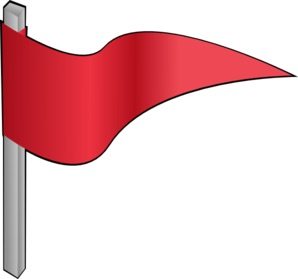
Unfortunately, not all practices are equal out there. Some abuse the junior employees. Others require responsibilities of their employees that the employer does not outline in the contract. And, even others promise partnership with its employees and do not deliver. So how do you know that your first job is going to work out for you? Well, it can be exceedingly difficult to tell for sure. But, I have come up with twelve red flags while employed or interviewing that will enable you to figure out if you need to move on to a new job or interview elsewhere.
No One Tells You Anything
You show up to work one day and discover that the hospital owners changed the location of your reading area within the imaging center without warning. Or, the private practice partners have a partners’ meeting and are unwilling to divulge any information, even non-sensitive information such as compliance issues for the employees. If this pattern of poor communication continues over time, it is a sure sign that the partners either have poor communication skills or do not respect the employees’ work. Be very wary!!!
Constantly Changing Work Responsibilities
You may be a neuroradiologist, but the practice expects you to all of a sudden read mammograms that you have not read for many years. And, the next week, you are responsible for all the arthrograms, even though you have not done one since your residency. If this happens once or twice, it may be related to staffing or temporary issues. On the other hand, when it is a recurring theme, it may be the first signs of an inept management structure unable to either retain its employees or, perhaps, severe practice disorganization. Think twice about staying!!!
Severe Isolation Syndrome
When you come into work, you see all the offices with radiologists with the doors locked. Just like everyone else, you shut your door too. And, you don’t even hear a peep from another radiologist for days at a time. Is this a collaborative environment? Certainly not!!! It doesn’t bode well for a fruitful, enjoyable long career!!!
No Practice Socialization Events
Most practices have some sort of get-together for the members of the group or hospital, whether it be the attendings, technologists, nurses, or other staff. And, there is a good reason for that. It is essential to get to know your colleagues so that you can feel comfortable relying on them as people. If none of these events are available, it sure seems that a lack of trust may be in the cards. Do you want to be part of a practice where you don’t even know your colleagues?
Hallway Brawls
OK. Perhaps, once in a while, a colleague does not get along well with another. However, if you find this a regular occurrence, there is a good possibility that your colleagues have significant personality disorders. Are you willing to deal with this behavior for the rest of your working career?
No Rewards For Good Employees
Sometimes your employees go above and beyond what the employer expects of them. Practices that ignore good employees also tend to overlook each other. How do you reward someone who is adding value to an imaging business? Well, you give them a bonus, extra vacation, or at the very least essential verbal recognition of their excellent work. If your practice can’t see how good you are and are working hard to better the business, consider going elsewhere!!!
Always Being Told You Are Wrong
Perhaps, you are missing a lot of findings or do not communicate well with colleagues and physicians. But, if you find that you are within the bell curve and your employees are constantly criticizing your work, did you ever think that they might just not want you there? Start looking around!!!
Running Around Like A Chicken Without A Head
Living in constant stress with tons of studies and responsibilities without end is not sustainable over the long run. Some practices run continually by having radiologists read too many cases to be safe. They are just in the business to make money for the bottom line of the partners’ pockets. Can you work in this sort of situation for the rest of your working life? Think about finding someplace where you can work over a long, sustainable period!!!
Lack Of Hospital Involvement
You notice that none of your colleagues or future employers is on committees within the hospital staff. If you want to stay relevant to your place of practice, at least someone needs to be involved. Otherwise, if there is no connection to the practice facilities, the ax may fall when you least expect it, and all of you may be out of a job!!!
No QI Committees
Believe it or not, quality is a crucial element of good practice. How do you know how you are doing? Well, there is only one way. You need to have someone that monitors the quality of the practice. Does the imaging business have morbidity and mortality conferences or peer evaluations? If your future coworkers are embarrassed to have their work checked, you may be looking at a practice that doesn’t care how they are doing. Start thinking about finding a practice that cares about the quality of their work!!!
No One Cracks A Smile
I find it a relief to crack a joke or say something nice and get a good response. However, some practices take themselves way too seriously. Do you want to be in a practice where everyone is miserable?
The Almighty Buck Always Rules The Roost
If you have not learned it yet, you will undoubtedly learn it at some point. It is not always about the money. Employers need to value ethics, practicality, and hard work over money at many points to run a genuinely great practice. If there is never a time that your future employer factors these attributes above the almighty buck, consider your alternatives!!!
So There Are Red Flags. Now What?
Not all practices are perfect, and it doesn’t necessarily mean that they are dysfunctional. However, when you catch a pattern of multiple red flags again and again without correction, it may be time to rethink your employment strategy. Keep your eyes wide open and your ear to the ground!!!














